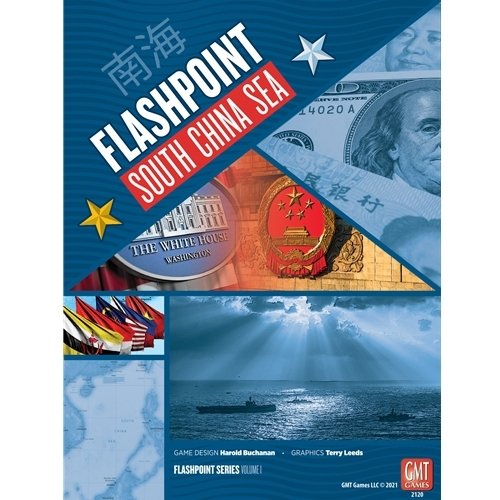-
Załączniki bezpieczeństwa
Załczniki do produktuZałączniki dotyczące bezpieczeństwa produktu zawierają informacje o opakowaniu produktu i mogą dostarczać kluczowych informacji dotyczących bezpieczeństwa konkretnego produktu
-
Informacje o producencie
Informacje o producencieInformacje dotyczące produktu obejmują adres i powiązane dane producenta produktu.GMT Games
-
Osoba odpowiedzialna w UE
Osoba odpowiedzialna w UEPodmiot gospodarczy z siedzibą w UE zapewniający zgodność produktu z wymaganymi przepisami.
Flashpoint: South China Sea is a two-player strategy game that simulates the complex geopolitical contest currently taking place between the United States and China in a disputed region of the South China Sea. The game is driven by a card deck that captures developments ripped straight from today’s headlines, bolstered by cards with a context-setting reading of recent history, and a set of speculative cards capturing a diverse range of potential future events.
The Chinese player works to influence other countries in the region, establish territorial claims and regional hegemony, and improve its world standing. The U.S. player works to maintain influence with allied countries in the region, secure freedom of navigation, and keep China in check. Success for both players hinges on the support and allegiance of non-player countries in the region. The game stops short of dealing with a potential full-scale military conflict. Rather, it requires the nuanced exercise of political, economic, and military resources, in a form of prima facie diplomacy – on the waters, in the air, and ultimately in the minds of the people – to achieve victory.
Each player manages a hand of cards that can be used immediately for various operations, or may be held for future operations under more favorable circumstances.
Strategically, there are several key focal points for the players:
- First, the US player bears the burden of keeping the region’s shipping lanes free and open. If the US player falls behind in Freedom of Navigation Operations, Chinese claims grow and game momentum will shift.
- Both players must take heed of the game’s Tension Track, which directly influences the impact of events. If the Track is not managed properly, a high level of tension can increase the stakes and derail the 'best-laid plans'.
- The Chinese player must work to improve Chinese World Standing, which affords them added influence as their World Standing increases. The US player can win by reducing Chinese World Standing to a critically low level.
- Protagonist countries in the region are key influence battlegrounds for the players. This represents the pragmatic reality that claimant countries in the region have unique impact on international dispute resolution mechanisms. If the Chinese can influence them to the point that they will not exercise those claims, the Chinese position is strengthened. If the US can influence and support them to consistently exercise their claims, China’s position is weakened. In the game, both players attempt to assert economic and military influence on these claimant countries.
- In order to increase the strength of their claims in the region, the Chinese can develop islands. This development will cost influence in the region and increase Tension, but is a cornerstone of Chinese strategy. To counter these claims, the United States must conduct offsetting Freedom of Navigation Operations. These Freedom of Navigation Operations help keep the Chinese claims in check but must be diligently maintained.
As the United States player, can you defend the claims of your allies, stare down the Chinese player in a high stakes game of chicken, and use your economic and military influence in the region to thwart China’s expansion? Can you erode or limit Chinese World Standing while frustrating their ambitions, without allowing Tension to get out of control?
As the Chinese player, can you use your developing economic and military power in the region to solidify your claims and develop strategic dominance of the region?
Flashpoint: South China Sea lets you determine how this conflict will play out in a fast-to-play, easy-to-learn game.
Components:
- 1 22 x 17" mounted map board
- 40+ wooden influence cubes and markers
- 60+ cards
- 2 six-sided dice
- 1 Rulebook and Designer Notes












